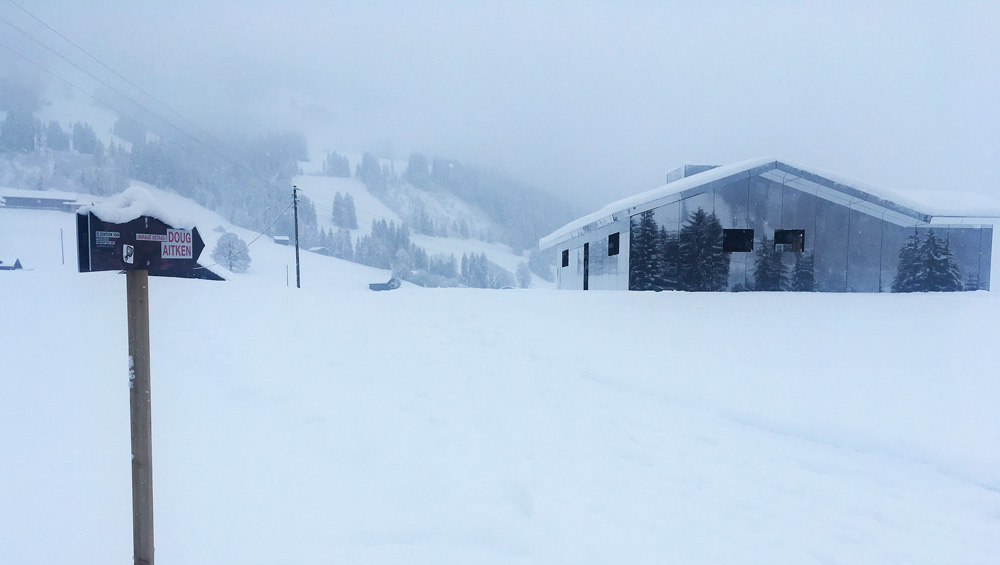
Doug Aitken, Mirage, installation view, Gstaad, 2019. Photo: Veronica Simpson.
Gstaad, Switzerland
1-3 February 2019
by VERONICA SIMPSON
I accept an invitation to the 2019 Elevation 1049 Festival: Frequencies – an art event in Gstaad, a Swiss resort for the super-rich – feeling something of an anomaly. I am far from rich. Nor am I particularly fond of – or knowledgable about – performance art, which is the focus of this, the festival’s third iteration. But I have come with an open mind and the desire to experience the work of Los Angeles-based artist Doug Aitken (b1968), who is staging a repeat of his Mirage (mirrored cabin) project in the mountains. (He installed Mirage in the desert outside Palm Springs in 2017 and in a former Detroit bank last year.) I am a guest of the Luma Foundation – one of the festival’s sponsors, along with New York and London-based The Store X Vinyl Factory. My travel, accommodation and meals are covered, so I am hoping the experience won’t bankrupt me, morally or financially. I have SFr100 (£70) in my pocket for emergencies.
After a three-hour train journey (the last hour a magical, slow ride through snow-feathered valleys and forests), I turn up to the first event of the evening at the impossibly glamorous Hotel Alpina (the ultimate winter “billionaire’s playground”, according to Forbes – at peak season, its best suite is $21,000 (£16,000) a night). Feeling damp and dishevelled after my walk from the station, I saunter as nonchalantly as I can into the lobby bar to experience Zhana Ivanova’s performance piece Borrowed Splendour. Ivanova (b1977, Russia) explains that it requires three strangers to follow her instructions. Allegedly, they are picked at random, but I later find out that one is the young chairman of the hotel (bearded, beaded and barefoot Nachson Mimran, son of the hotel owner Jean-Claude Mimran, the so-called “Sugar King of Africa”), the second is Pierre Collet, Luma’s main communications man, and the third is a young woman who may, for all I know, also be someone important.
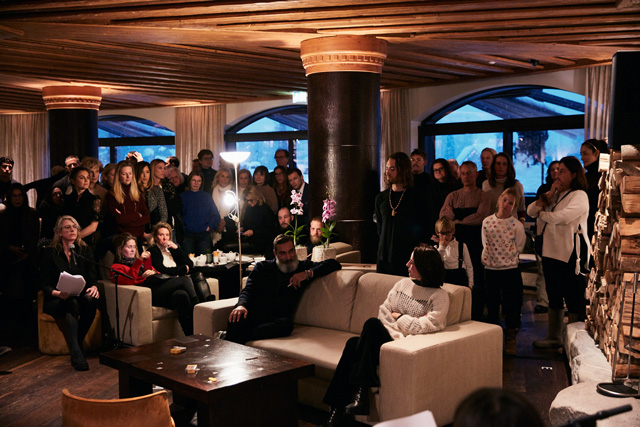
Zhana Ivanova. Borrowed Splendour, 2019. Photo: Torvioll.
For 20 minutes, we observe them obey instructions, circling around a sofa, a chair and a coffee table, their body language shifting from flirtation to rejection and back again. It is vaguely illuminating, vaguely amusing, but no more so than any other parlour game. I grab my bags and head for one of the many courtesy SUVs assigned to take the festival’s audience from one venue to another over the weekend. On my way out, I narrowly avoid being rammed by one of several remote-controlled cars filled with human hair and zooming around the hotel’s forecourt. They are by artist Nina Beier (b1977, Denmark) and are part of her work Automated (from her series of “confused objects”).
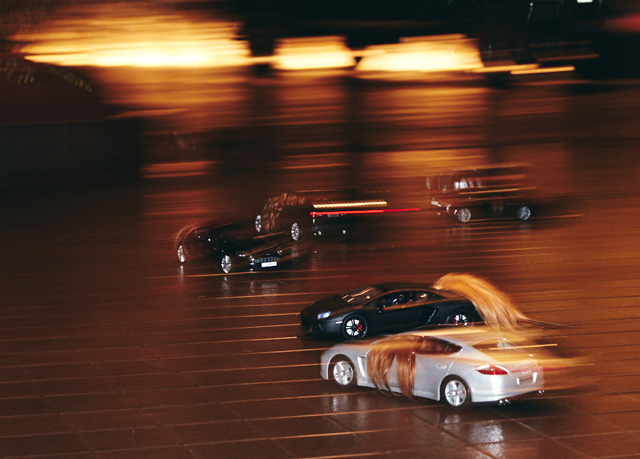
Nina Beier. Automated. Installation view, Hotel Alpina, Gstaad, 2019. Photo: Torvioll.
Having dumped my bags at the hotel where I am staying (a 20-minute ride from Gstaad and the Alpina), I return to Gstaad and the next sumptuous venue: the GreenGo, a subterranean nightclub attached to the spectacularly opulent Gstaad Palace hotel. I am early. I kill time in the hotel lobby, perusing the diamond shops and display cases filled with gem-encrusted trainers. I feel – and no doubt look – hilariously out of place. I pay a heart-stopping SFr30 (£23) for a single Aperol spritz and am grateful for the crisps and nuts the barman hands me in a silver dish.
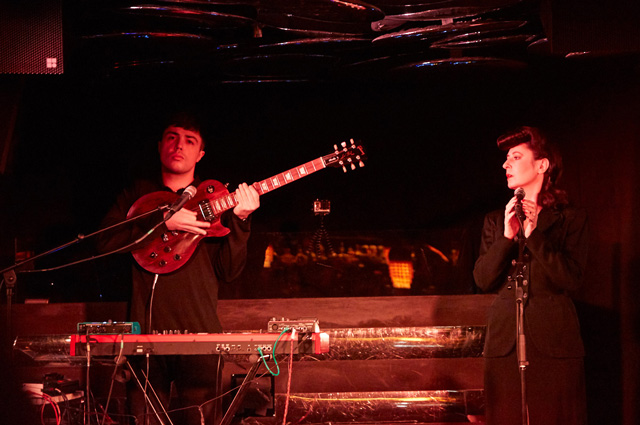
Dominique Gonzalez-Foerster performing at the Greengo bar, Gstaad Palace Hotel, 2019. Photo: Torvioll.
When the time comes to enter the GreenGo, it is packed. The decor is pure 1970s, a melange of crocheted orange pendant lamps, mirrored walls, velvet banquettes and a ceiling that appears to be made of silver flying saucers. Here is the festival audience at large, sequinned to the max: the cream of central Europe’s gallery gurus and curators from Berlin, London, Madrid, Milan, New York, Paris, Venice and Zurich, plus some choice collectors and a smattering of artists from around the globe. A young Berlin-based gallery assistant tells me that if the gallery were invited to more events like this, it wouldn’t need to go to art fairs. The palpable buzz I am sensing is clearly the high-octane frenzy of anticipation at lucrative networking prospects; or just the thrill of being among such a starry cast. It is lost on me.
I am impressed, though, by Dominique González-Foerster (b1965, Strasbourg) as she steps up to the microphone. She looks stylish and severe, like Dita von Teese’s bossy big sister. She sings in either French or German, so my comprehension isn’t 100% but the snatches I understand are distinctly dystopian: the music has the haunting synth and melancholy soundscapes of Blue Velvet or Blade Runner. I realise that she is dressed as Rachael, the glamorous replicant that Rick Deckard (Harrison Ford) falls for in the latter movie. But is this art, or is it music? Does it matter? At one point an up-tempo drumbeat kicks in and González-Foerster starts dancing, badly, out of time. Now that – the discomfort of watching someone who is clearly a professional dancing like a talentless amateur - would bring this closer to what I expect from performance art. By the end of her set (and two glasses of free wine) I am ready to buy the album – her second, Exotourisme, which is, as it happens, freshly released by the Vinyl Factory.
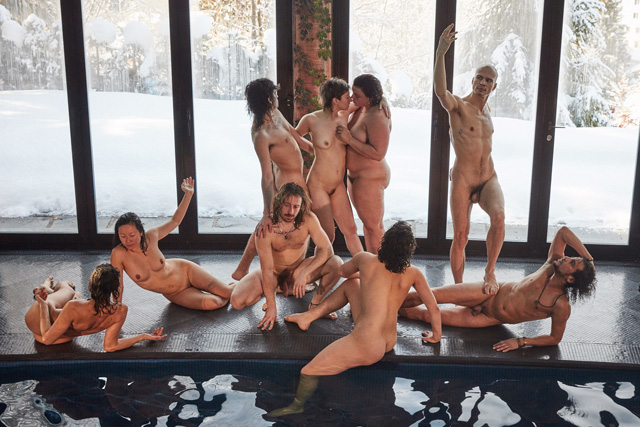
Isabel Lewis. Poolside Pastoral, performance, 2 February 2019, Vieux Chalet, Gstaad. Photo: Torvioll.
The following day’s events begin with full-on nudity. Not mine, thankfully. I turn up late for Poolside Pastoral by Isabel Lewis (b1981, Dominican Republic), having missed the courtesy car from my hotel; it costs me a stonking SFr47 for the 16-minute taxi ride. I reach the luxurious Vieux Chalet, a private residence with an Alexander Calder on the front lawn, 15 minutes from the end of the two-hour performance. I am ushered on to a steamy pool-house terrace where two dozen young men and women are draped, spreadeagled or seated wearing nothing at all, or nothing from the waist down. They are reading poetry. Apparently, I have missed the synchronised swimming. For a while it is charming to observe them, so at ease in their skins, reciting poems, sharing their vulnerability, but when one girl starts yelling loudly and repeatedly, in an extremely unmusical fashion, into the echoing indoor lagoon, I leave.
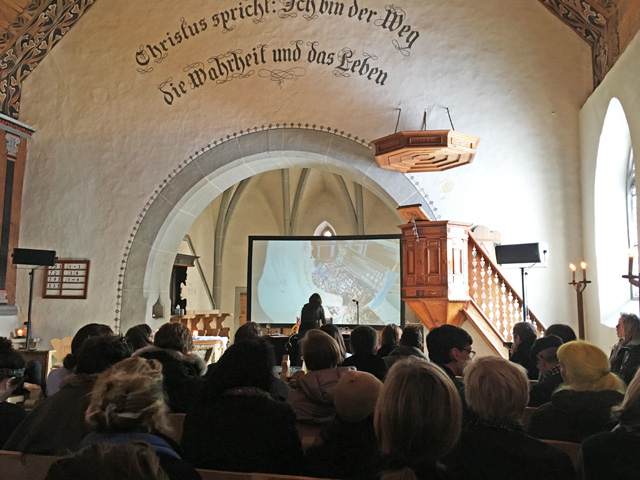
Suzanne Ciani playing Improvisations on Five Sequences, 2019. Photo: Veronica Simpson.
The prospect of a concert by the sound-art legend and multiple Grammy-nominated composer Suzanne Ciani (b1946, Indianapolis) playing Improvisation on Five Sequences has filled an old, delightfully plain Presbyterian church in the village of Lauenen, about five miles from Gstaad. In the altar space is a table bearing some chunky analogue equipment, a mess of wires and some iPads: Ciani’s beloved Buchla synthesizer. She stands over it, with her back to us, like some kind of priest or shaman, crouching over the nobs and dials. A giant screen placed above the altar shows her hands and arms moving restlessly over the equipment, along with a whirling vortex of geometric shapes that pulse while the music plays. Forty minutes in, she has cleared all the children from the building, but the rest of us are rooted in place by her mesmerising, mind-altering music.
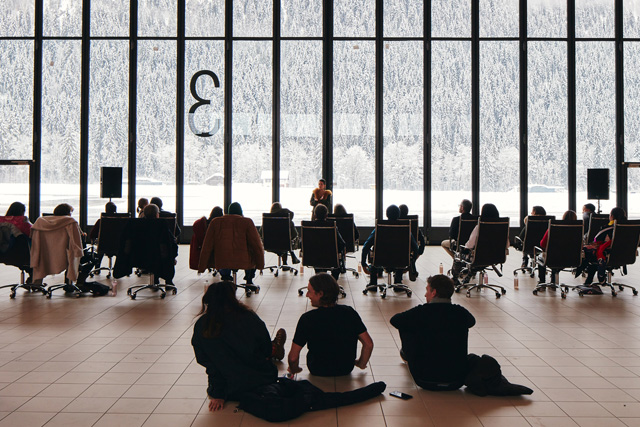
Liz Magic Laser. Elevation festival, 2019. Photo: Torvioll.
After a lunch of cheese and ham with Glühwein, I skip the next event, Liz Magic Laser’s guided meditation in a private aircraft hangar, and embark on my own walking meditation through the snow back to town (guided by Google Maps). After half an hour of being almost run off the road several times by grumpy Swiss drivers (there is no pavement), I find a cycle path, which I take with gratitude. For the next hour, I have the mountains and the route blissfully to myself. I remember to halt my crunching footsteps and stand still occasionally, to hear that wonderful, snow-soaked hush. Twice I chance on a tree full of birds, singing at full throttle: a proper four-dimensional, immersive, sculptural interaction with nature.
Adrift and off-schedule in Gstaad’s town centre, I persuade an Elevation 1049 driver to give me a lift to my hotel, seeing as it is near the next event. A nice Portuguese man called Ruy – all the drivers are Portuguese, it seems – tells me he has been here four years, and likes it well enough, although he misses the sun. He wishes the influential, international artworld would take more interest in artists living in the region, he says, such as his friend Ernesto, who is Swiss, although he studied in London. Ernesto paints constantly, but nobody has ever taken an interest in his work. He is shy, says Ruy. We agree this is a handicap in the artworld. I suggest I could look at his work online and maybe mention it. He gives me his friend’s website (baltiswiler.com).
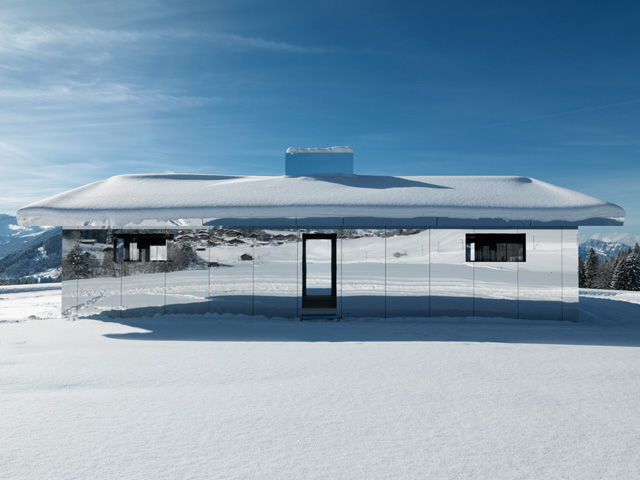
Doug Aitken, Mirage, installation view, Gstaad, 2019. Photo: Stefan Altenburger.
Luckily, despite a lack of signage, I find Aitken’s Mirage Gstaad easily. It is off the road, although near to a footpath. A ranch-style structure, clad inside and out with mirrored panels, its flat, reflective surfaces create a fascinating interplay with mountains, skies and people. It is almost impossible to take a bad picture of it: Instagram gold. I step away from the crowd, who are snapping selfies and networking over Glühwein, to chat with the Swiss maintenance man standing guard to ensure no one spills anything on Aitken’s immaculate wooden floors. Does he think local people might come to this festival? “No,” he says. But as to this Mirage structure, which will stand for the next two years, he says: “This we will enjoy.”
The day’s finale is Burned Bridge by Marianne Vitale (b1973, East Rockaway, New York). I decide to give it a miss. Surely that’s just the super-rich version of a bonfire: to ask an artist to make a sculpture out of wood, and then set fire to it? I prefer the thought of relaxing in my cosy hotel room, after a swim in the heated, outdoor, saltwater pool.
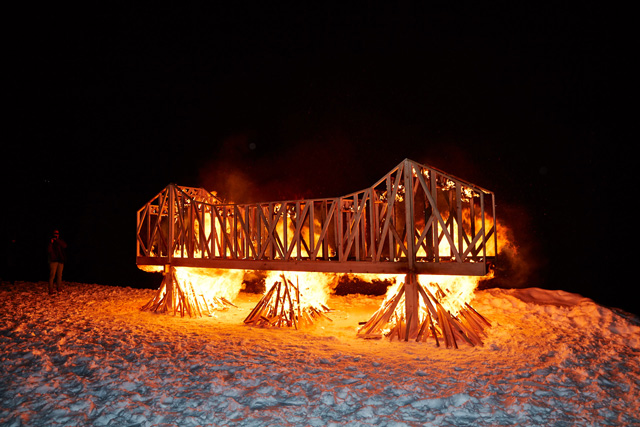
Burning Bridges by Marianne Vitale, 2019. Photo: Torvioll.
At the following morning’s talk between Aitken and the curator and writer Neville Wakefield (who shares the curatorial credits for this event with Olympia Scarry), various interesting points are made about the value of taking art out of the gallery. Aitken says that, as our lives become more richly stimulated by and connected to the virtual, interactions with things that are real become more important. “We want the physical world,” he says. “We want to touch something. We want to touch a rock and know that we can be cut by it; it’s not a flat image speeding by. That plays into art right now, very much. A lot of people I have dialogues with, friends of mine, other artists, they have this desire to discover things. They want to go out, and they want to find something else, in a place that’s not a mediated situation, not a controlled environment. They want the idea of experience and activation. And that’s one of the things I was very interested in exploring with Mirage here. Can we make something that we can just give away? It’s there for the long haul. It’s there to change and transform over time, but it’s for you to go there and get cold, or lie there in the hot summer sun, or go under a full moon. I love this idea that an artwork can be out there living autonomously.”
But do we need art in order to have such visceral encounters? Do we need Aitken’s generosity? After all, nature – the ultimate immersive environment, as my walking meditation testified – is free. However, early the next morning I trudge through heavy snowfall to spend a little time on my own with Mirage Gstaad, and decide that this is a destination worth a little legwork, and would be a joy to have in my locality: a great excuse for moonlit walks or summer picnics.
Ultimately, regardless of what the art world elite thought, for me the weekend was a success: with just a SFr20 pizza to pay for on the Saturday, I end the adventure on budget, uncorrupted by the lifestyles of the super-wealthy and, while entertained by the art, I am not moved by any of it more than I am by the timeless landscape around it. Perhaps that’s the danger of trying to programme art – especially so much ephemeral stuff – in such a setting.